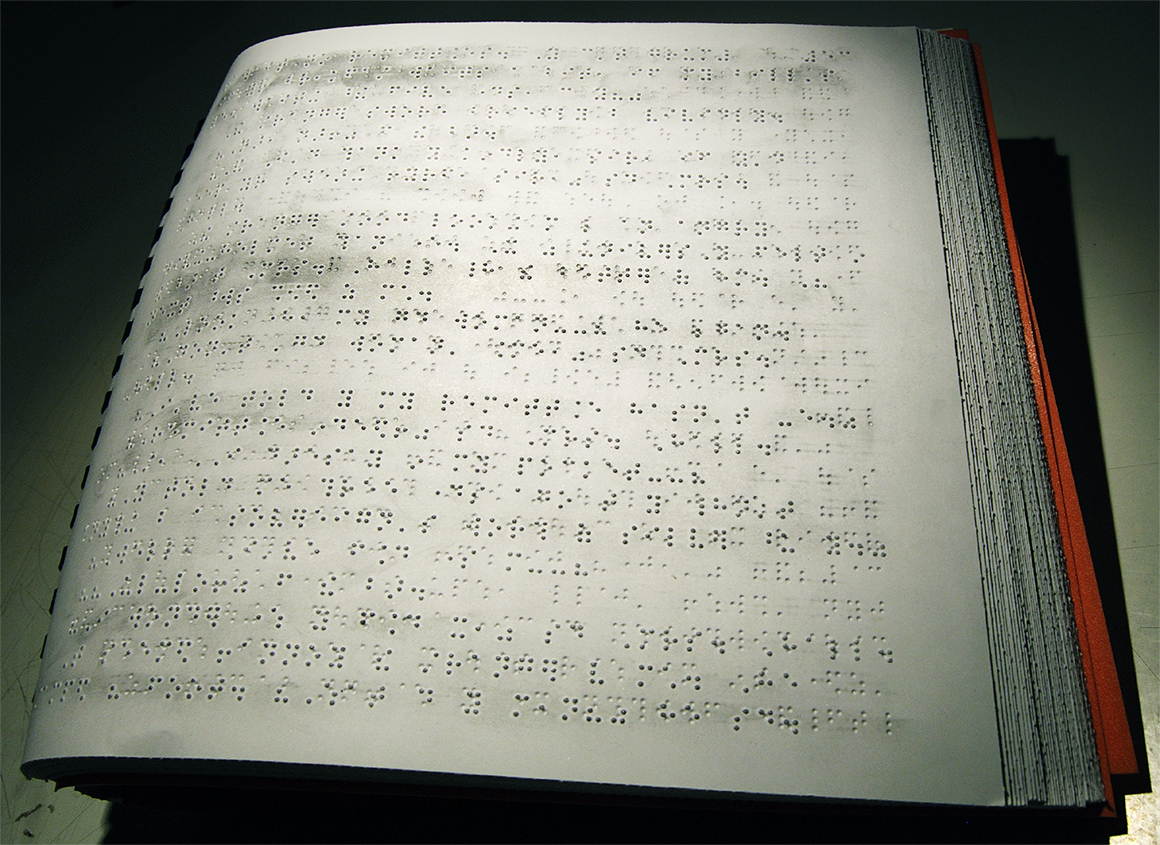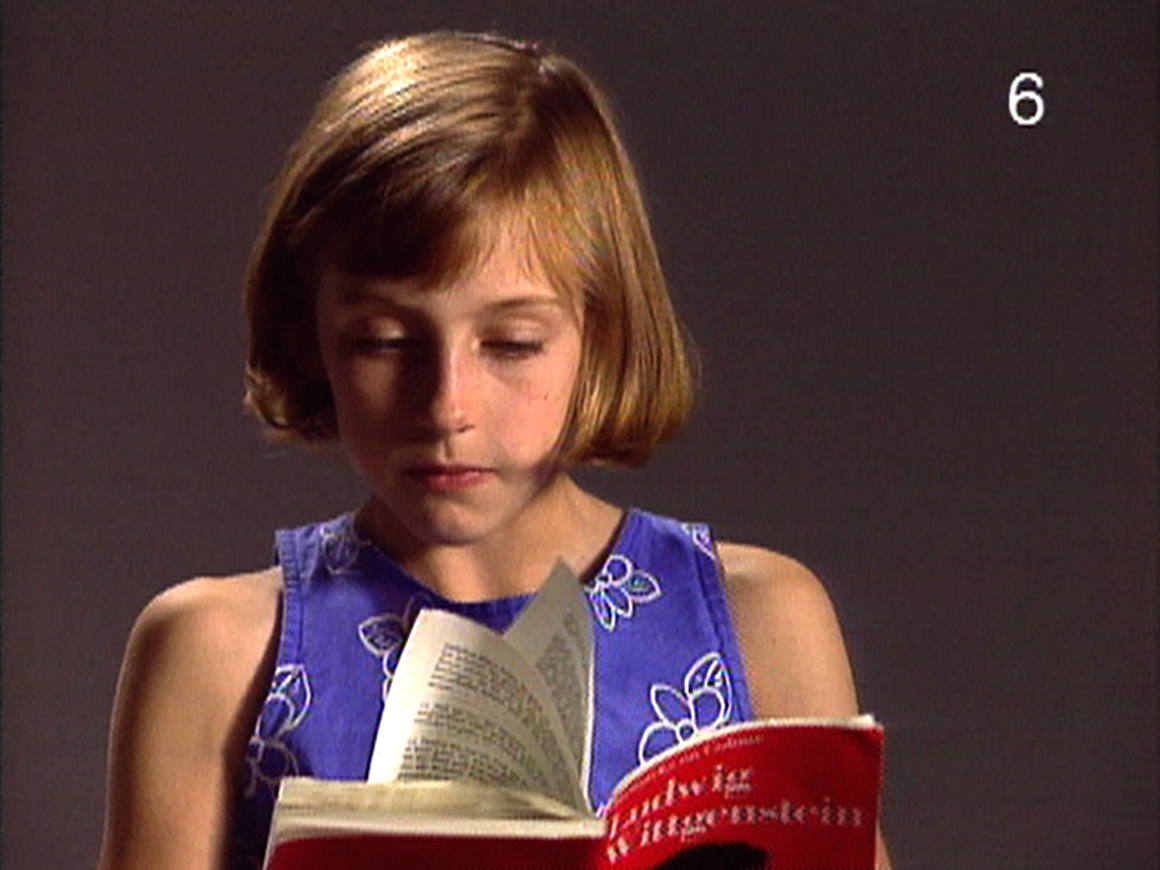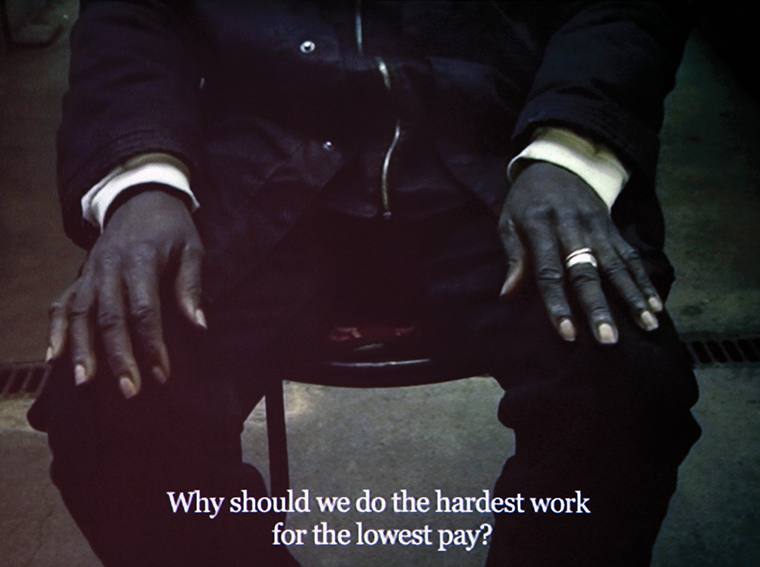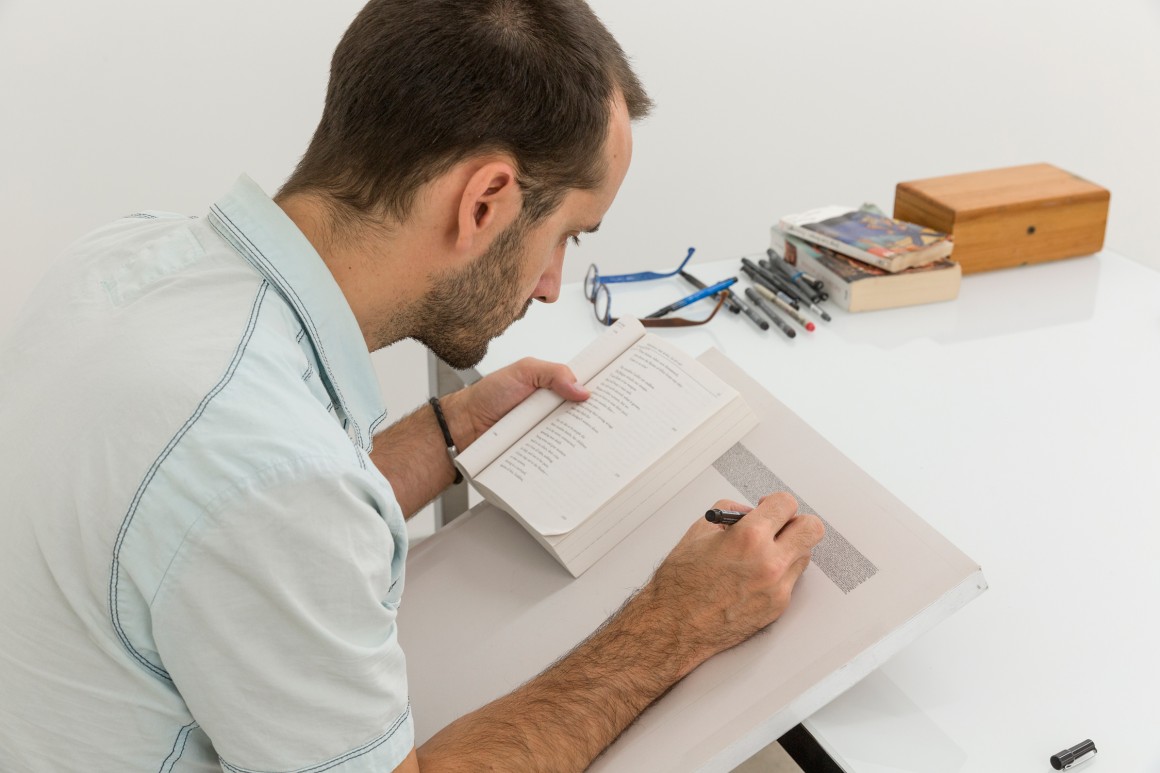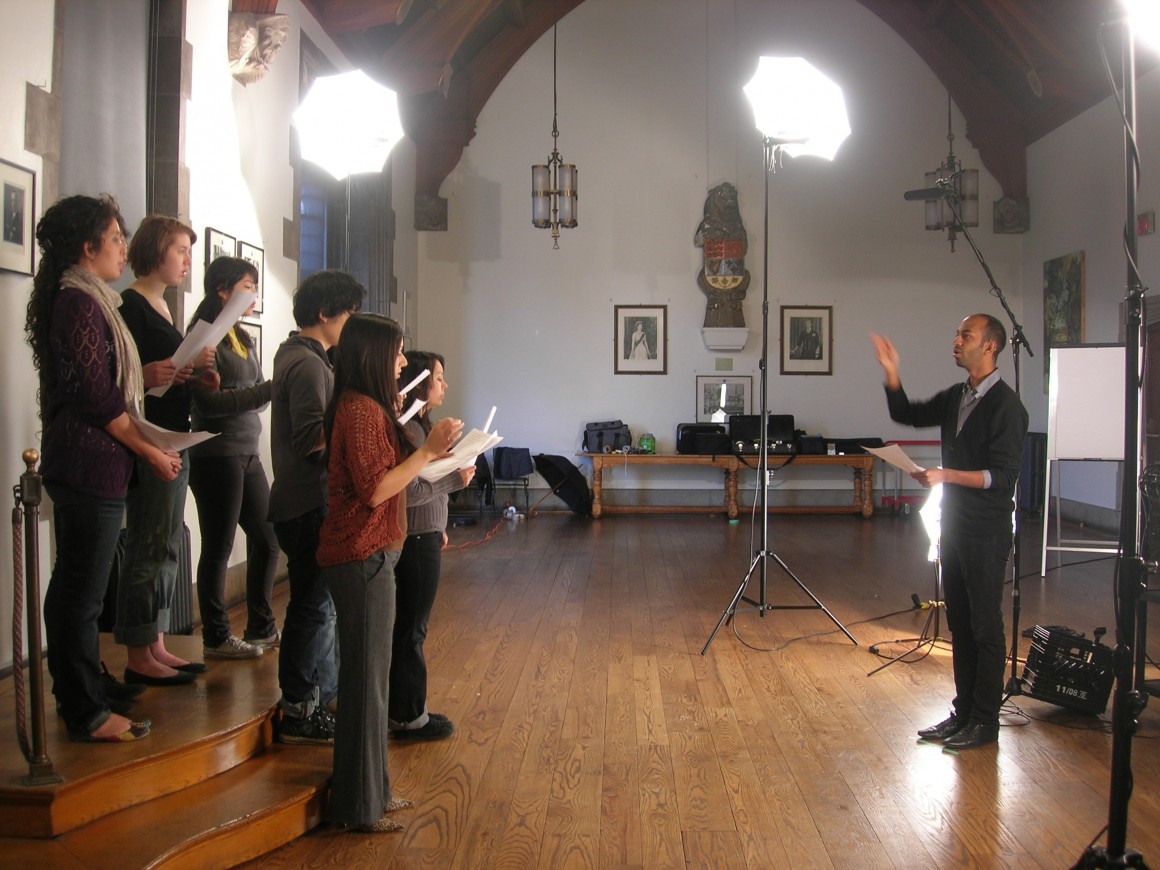Recently, many concerns have been expressed regarding the impact of socio-technological developments on our relationship with knowledge, language, and the written word: among these are the decline of reading, the crisis in the book publishing industry, the deterioration of students’ linguistic and interpretative skills, higher education geared less towards being well-read and more towards an ever-expanding knowledge-based economy, the erosion of reflexive attention, even the threat of mass mindlessness. Although the current situation may seem alarming, most of these issues are not new. In 1988, philosopher and essayist George Steiner already expressed his concern over the imminent demise of book-culture in the face of the overwhelming number of new electronic information and entertainment media (at the time, chiefly television, radio, and video games), which he charged with “appropriating the resources of time and of perception which were once the domain of the book.”1 Symptomatic of a nostalgic attachment to classical modes of reading based on the idea of a profound, silent, and concentrated literary experience, this type of discourse has proliferated in recent years, forming a melancholic lament against the establishment of a “new regime of digital distraction dominated by the image and hyperlink.”2 For example, Nicholas Carr asserts, in his book The Shallows: What The Internet is Doing to Our Brains (2010), that the information overload that we are exposed to through technology entails an inevitable degradation of the reader’s brain, and, correlatively, a radical shift in our modes of thinking associated with the arts, letters, and humanities.3 Without denying the significance of these transformations, which are supported by a plethora of scientific studies,4 the question arises, however, whether recognizing the upheavals affecting reading practices in the age of “screen culture” must necessarily mean mourning a bygone era. At this critical juncture in our cultural and intellectual history, is it not rather an opportunity to reconsider the act of reading in its intrinsic complexity, and, in doing so to restore its critical status?
This is precisely the question that the exhibition Reading Exercises addresses through artworks and projects that, each in their own way, speak to a renewed relationship to reading, conceived as a space for productive experimentation and critical investigation. In response to a situation whose stakes reach far beyond the academic sphere—and Western borders, for that matter—the exhibition examines how different strategies implemented by artists and thinkers affiliated to the art world are contributing to reopening the debate on what it (still) means and implies to read in our day and age.
Katrie Chagnon
- George Steiner. “The end of bookishness?” Times Literary Supplement, July 8-14 1988: 754. Reference should also be made to the work of art historian Jonathan Crary on human attention, which suggests that the problem of distraction in fact dates back to the late 19th century, with the emergence of modern industrialization. Jonathan Crary, Suspensions of Perception: Attention, Spectacle, and Modern Culture (Cambridge and London: MIT Press, OCTOBER Books, 1999).
- Yves Citton, Pour une écologie de l’attention (Paris: Éditions du Seuil, 2014), 190 (my translation).
- Nicholas Carr, The Shallows: What The Internet is Doing to Our Brains (New York and London: W. W. Norton & Company, 2010). In this book, Carr argues that, in general, reading on screen and using the Internet affect not only cognitive brain function but also its morphological structure.
- These studies are too numerous to list here. See the excellent synthesis by N. Katherine Hayles in her article “How We Read: Close, Hyper, Machine,” ADE Bulletin 150 (2010): 62-79.
Hearing Reading
For the duration of the exhibition, Hearing Reading presented each week a video conversation in which a member of the Concordia University community talks about his/her specific reading practices.
Concept Hearing Reading: Corinn Gerber, Project Coordination: Laura Horrocks-Denis
All the videos can be watched in the Audio | Video section.
Last video: Zoe Wonfor
The complete essay written by the exhibition curator Katrie Chagnon can be viewed and downloaded in the Texts and Documents section.
We would like to thank the artists and the many people who have contributed to the conception and realisation of this exhibition. The exhibition was also made possible with the collaboration from René Blouin, Montréal ; Polaris, Paris ; and Frith Street, London ; as well as from the Musée d’art contemporain de Montréal.
Produced with the support of the Frederick and Mary Kay Lowy Art Education Fund.
The Leonard & Bina Ellen Art Gallery’s contemporary exhibition program is supported by the Canada Council for the Arts.
CURATOR
Katrie Chagnon is Max Stern curator of research at the Leonard & Bina Ellen Gallery, Concordia University. A doctoral candidate at Université de Montréal, she is working on a critical, psychoanalytical, and feminist analysis of the role of phantasy in the work of contemporary art historians Michael Fried and Georges Didi-Huberman. She has also been involved in the contemporary art milieu for over ten years as an author, art critic, and curator. Notable publications include the study Phénoménologie et art minimal: une mise à l’épreuve critique de la dialectique œuvre-objet dans l’esthétique phénoménologique (Presses universitaires européennes, 2010), a monograph on Quebec artist Alexandre David (forthcoming in 2016), as well as numerous articles, essays, and exhibition catalogue texts. She lives and works in Montreal.
ARTISTS AND WORKS
Fiona Banner was born in Merseyside, UK, in 1966. She gained her BA in Fine Arts at Kingston Polytechnic in 1989, and her MA in Fine Arts from Goldsmiths College in London in 1993. In 2003, she was shortlisted for the Turner Prize. Much of Fiona Banner’s work explores the problems and possibilities of written language. Her early work took on the form of “wordscapes” or “still films” – blow-by-blow accounts written in her own words of feature films (whose subjects range from war to porn), or sequences of events. These pieces took the form of solid single blocks of text, often the same shape and size as a cinema screen. Banner’s current work encompasses sculpture, drawing and installation, but text is still at the heart of her practice. She recently turned her attention to the idea of the classic, art-historical nude, observing a life model and transcribing the pose and form in a similar vein to her earlier transcription of films. Often using parts of military aircraft as the support for these descriptions, Banner juxtaposes the brutal and the sensual, performing an almost complete cycle of intimacy and alienation.

Trance, 1997
Talking Book
22 audiotapes, drawing and plastic tape box
Audio recording transferred on digital support, 13 hours
Edition of 10
Courtesy of the artist and the Frith Street Gallery, London
Trance is a thirteen-hour recorded reading performance by British artist Fiona Banner of her book The NAM, which she had written the same year. In this book, Banner has described shot-by-shot, over 1,000 pages, six entire famous Vietnam War movies – Apocalypse Now, The Deer Hunter, Hamburger Hill, Platoon, Full Metal Jacket, and Born on the Fourth of July – as if to constitute one long film script. Trance was conceived in response to critics who described The NAM as an “unreadable” book. Together, these two works raise the hermeneutical question of the readability of texts: a question of extreme relevance today given the growing prevalence of attentional constraints widely attributed to our use of technology.
The reading was originally recorded onto 22 individual audiocassette tapes by the artist in 1997. In 2012 the recording was transferred to digital for conservation purposes.
A copy of the book The NAM is available for consultation at the gallery’s front desk.
LINKS
Artist’s website
Vanity Press (artist’s press)
Heart of Darkness at Four Corners Books, 2015
Interview with Fiona Banner by Natalie Hegert in Huffington Post, 2015
Alan Woods, “Reading the NAM” in Afterall Journal (see also: Matthew Higgs en conversation avec Fiona Banner, même numéro), 1998
Review of The NAM by Stephen Bury in Art Monthly, 1997
Fiona Banner profiled by David Barrett in Art Monthly, 1996
Born in 1980, Simon Bertrand completed an MA in visual and media arts at the Université du Québec à Montréal. In 2011, he has received a grant from the Canada Council for the Arts for his project Retranscription of Aeneid. He participed in the Symposium international d’art contemporain de Baie-Saint-Paul, among others, and his work is in many private collections in Quebec and Canada. Since 2014, he has been represented by Galerie René Blouin.
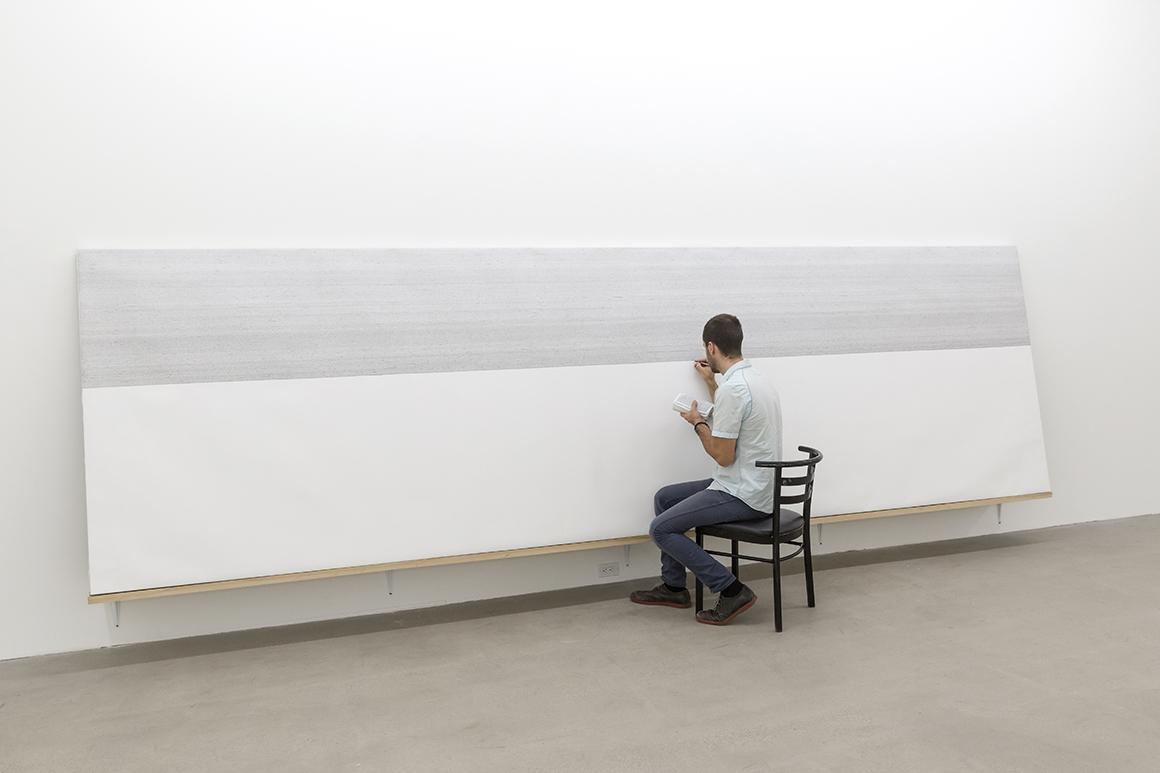
Retranscription of La Bible – nouvelle traduction, 2009-…
Paper, 0.05 ink pen, wood and La Bible – Nouvelle traduction
Courtesy of the artist and Galerie René Blouin, Montreal
Reading as a temporal challenge takes on considerable proportions in the work of Simon Bertrand, whose practice of retranscription renews the ancient figure of the scribe (or copyist), once responsible for the transmission of knowledge through the written word. By setting himself the daunting task of recopying by hand the entirety of certain “great founding narratives”1 of Western culture, such as the Epic of Gilgamesh, Homer’s Odyssey, Sophocles’ Oedipus Rex, and even the Bible, the artist introduces anachronism into our contemporary literary experience. In doing so, he invites us to reflect on the meaning and place that can still, in our day, be granted to these canonical texts. During the exhibition, Bertrand pursues his inaugural and programmatic Retranscription of the Bible – New Translation, a long-term project begun in 2009. Characterized by its imposing dimensions, calculated at the scale of the text in its visual transcription, this work incarnates the temporality of the act of rereading, embodied in the scriptural gesture of the artist and the movements of his body traversing the surface of the page from one edge to the other. Yet the apparent virtuosity of the exercise is at variance with the numerous erasures that mark errors and underline the imprecision and awkwardness of the manual gesture.
The artist will work on the transcription and interact with the public during the opening, as well as on Saturdays throughout the exhibition (November 21st, December 5th and 9th, and January 16th ), between 2 and 5PM.
- This expression is borrowed from Thierry Hentsch, Raconter et mourir: aux sources narratives de l’imaginaire occidental (Montréal: Presses de l’Université de Montréal, 2002).
LINKS
Artists’ website
Nicolas Mavrikakis on Mona Hatoum and Simon Bertrand at René Blouin Gallery in Le Devoir, 2014
Videoportrait of Retranscription of La Bible on La fabrique culturelle, 2014
Chantal Guy on the exhibition Assembler, dessiner, transcrire at Galerie de l’UQAM in La Presse, 2009
Born in 1972 and raised in New Orleans, Clayton Cubitt is a photographer, filmmaker, and writer based in New York City. He moves between the worlds of art, fashion, advertisement and music, and is the creator of the viral video art series, Hysterical Literature. He has worked for a variety of editorial and advertising clients, including Brand New School, Converse, The Guardian, Nike, Microsoft, Rolling Stone, Smithsonian, Vogue, and The Times Magazine. His work has been exhibited at MASS MoCA and Prospect Biennial, among others. It has been written about in Dazed & Confused, Vanity Fair, Interview Magazine, Nowness, and Tokion, among others. His art and music videos have been viewed over 50 million times.
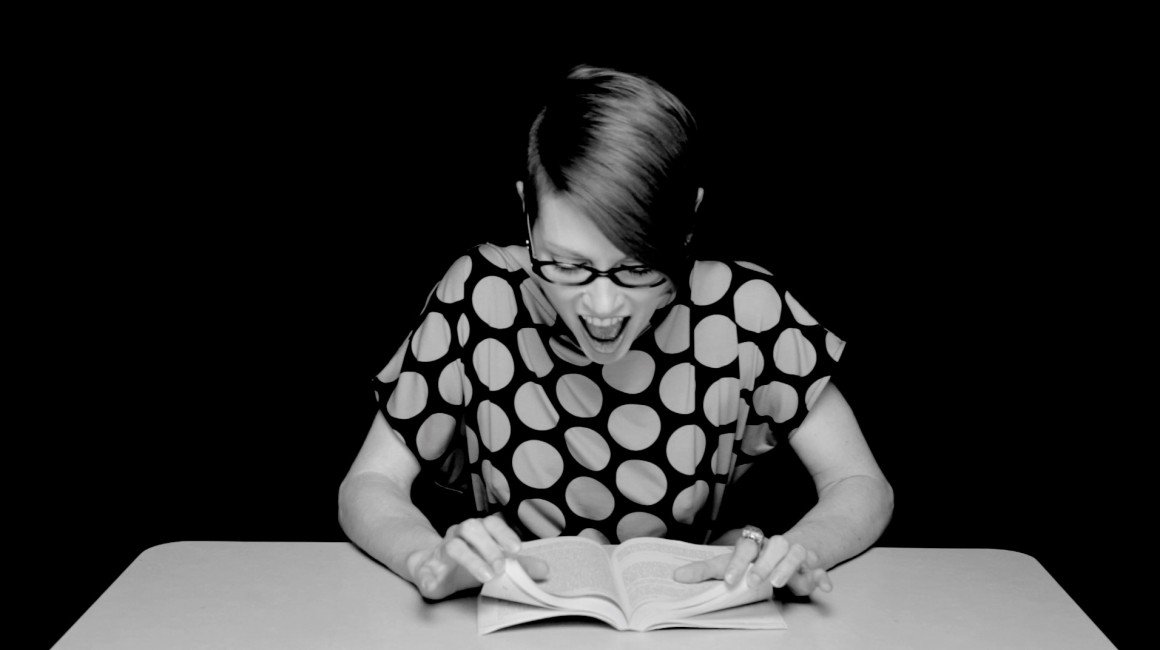
Hysterical Literature, Sessions 01-11, 2012-2015
Series of 11 videos
Variable durations
Courtesy of the artist
Hysterical Literature, by New York filmmaker and photographer Clayton Cubitt, consists of a series of 11 video sessions, each 5 to 10 minutes in length, in which women seated at a table read aloud excerpts from literary works of their choice while facing a camera. Unbeknownst to the viewer, an assistant positioned beneath the table stimulates the reader with a vibrator. This consensual interaction is beyond the reader’s control: their reading, at first concentrated, becomes disrupted, punctuated with hesitations and efforts to regain composure, until the subject finally succumbs to orgasm. Streamed on the Internet and viewed over 45 million times in 200 countries, these videos explore the relationship between the textual and the sexual, the body and the mind, and hence the tenuous frontier that separates eroticism from pornography in art, while avoiding the adoption of their visual and aesthetic codes. Relating the female orgasm with the “pleasure of the text,” to borrow the words of Roland Barthes, this project highlights the discomfort elicited by the expression of female sexuality to this day, and questions the feminist implications of its representation by a man.
The Hysterical Literature series and related essays are available online at: hystericalliterature.com
LINKS
Artists’ website
Hysterical Literature
Clayton Cubitt on Vimeo
Interview with Ana Finel Honigmann in Interview Magazine
Ricardo Cuevas is working from a conceptual framework based in text, books and photography, with its various discourses around selection, the document, and the archive. His work is constantly probing the potential for misunderstanding, translation, and fragmentation. Ricardo Cuevas was born in Mexico City in 1978. He has participated in several international group exhibitions including 10 Mexican Photographers: A Select End-of-the-Century Generation (Lehigh University Art Galleries, Pennsylvania, USA), Never Odd or Even (Marres House for Contemporary Culture in Maastricht and Revolver Archiv für aktuelle Kunst Frankfurt), Master Humprey’s Clock (Stanley Brouwn pavilion, de Appel Arts Centre in Amsterdam), and Das phantastische Geheimnis des exotishen Universums (Galerie Ostermeier in Berlin). Most recently, he took part in the Third Guangzhou Triennial. His first solo exhibtion was shown at the Banff Centre for the Arts in 2003. In 2005, he presented Beyond Love and Democracy, a solo exhibition, at Gallery 44 in Toronto. His work has been reviewed by The New York Times and The Globe and Mail. In 2007, he was awarded with a residence at the International Studio and Curatorial Program in New York City.

Index/Criminal Offenses, Chapter 11, 2008-2015
7 braille books, graphite
Courtesy of the artist
Index/Criminal Offenses, Chapter 11 (2008-2015) is a performative work created by Mexican artist Ricardo Cuevas in response to the USA PATRIOT Act. Introduced in the wake of the events of September 11, 2001, this law grants the American government with the right not only to monitor the phone calls and emails of anyone suspected of terrorism, but also to access lists of publications borrowed from public libraries. In order to highlight this infringement of intellectual freedom—which has been denounced by numerous American library associations—Cuevas asked blind people to read certain pages of books in Braille, which he had previously covered with graphite, thus conserving the traces of their fingers moving across the page. Originally performed in 2008 as part of a residency at the International Studio and Curatorial Program in New York, this drawing exercise was reenacted for this exhibition using copies of The Aleph (1949), a collection of short stories by Jorge Luis Borges printed in Braille in four parts, and Pedro Páramo, a novel by Juan Rulfo printed here in three parts. By literally rendering visible the act of reading and its traceability, Index/Criminal Offenses reveals that exercising our right to think freely is no longer possible without considering the ideological control to which our socio-cultural behaviour is subjected in the context of current policies on access to information.
This work is presented in the foyer of the Webster Library, located on the 2nd floor adjacent to the Gallery.
LINKS
Artists’ blog
Never Odd or Even #2, edited by Mariana Castillo Deball, 2011
(#1 including a contribution by Ricardo Cuevas is out of print)
From Aachen to Iser at Darling Foundry, Montreal, 2011
Master Humphrey’s Clock at deAppel, Amsterdam, 2008
Brendan Fernandes is a Canadian artist of Kenyan and Indian descent. He completed the Independent Study Program of the Whitney Museum of American Art in 2007. He earned his MFA from The University of Western Ontario in 2005, and his BFA in 2002 from York University in Toronto. He has exhibited internationally including at the Solomon R. Guggenheim Museum, the Museum of Arts and Design and Art in General, and Sculpture Centre in New York City, the Musée d’art contemporain de Montréal, The National Gallery of Canada in Ottawa, The Andy Warhol Museum in Pittsburgh, the Art Gallery of York University in Toronto, Deutsche Guggenheim in Berlin, Bergen Kunsthall, Stedelijk Museum in Amsterdam, The Quebec City Biennial, The Third Guangzhou Triennial, and the Western New York Biennial through The Albright-Knox Art Gallery. He was a finalist for the Sobey Art Award in 2010, and was on the longlist for the 2013 and 2015 prize. A national Canadian tour of his work, organized by the Kitchener-Waterloo Art Gallery, continues to travel into 2016. He is currently participating in Disguises: Masks and Global African Art, organized by Seattle Art Museum that will tour to the Fowler Museum of Cultural History, Los Angeles, and the Brooklyn Museum, New York City. He is the recipient of a 2014 Robert Rauschenberg Residency Fellowship, and in 2016 he will be artist in residence at Northwestern University in Evanston in the Department of Dance Studies.
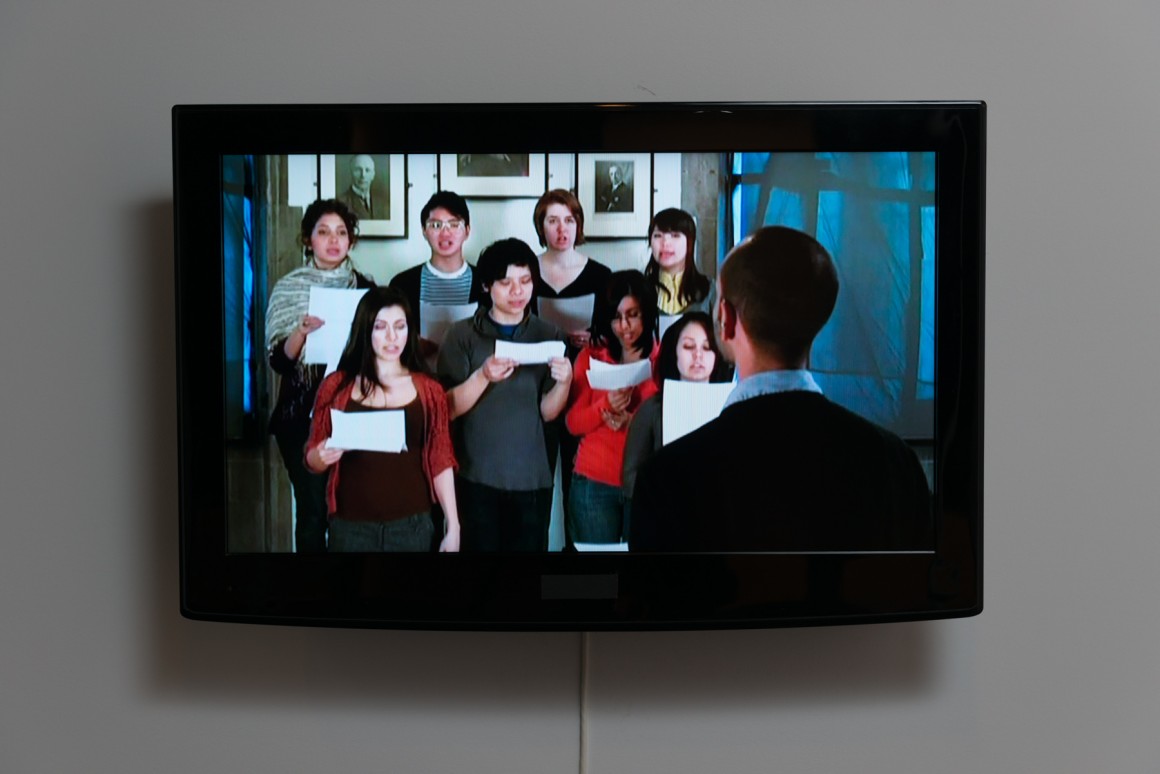
Performing Foe, 2009
Video
2 min. 41 sec.
Courtesy of the artist
Performing Foe is a sequel to a video entitled Foe (2008) which shows the Kenyan-Indian-Canadian artist receiving lessons from an acting coach hired to teach him how to enunciate the accents corresponding to his cultural roots. More interested by the learning of these accents than by their so-called “authenticity”, Fernandes repeats the sentences dictated by his instructor. These words and sentences have been extracted from the novel Foe (1986), a key post-colonial literary work inspired by the story of Robinson Crusoe and written by South African author J. M. Coetzee. The artist has retained the passage in which Crusoe relates that Friday (the “savage”) has had his tongue cut out, thus losing his ability to speak. In Performing Foe, Fernandes reads the same pages, but inverts the roles: this time, he plays the teacher, while a group of multi-ethnic students standing before him like a choir recite Coetzee’s words, mimicking his own feigned accent.
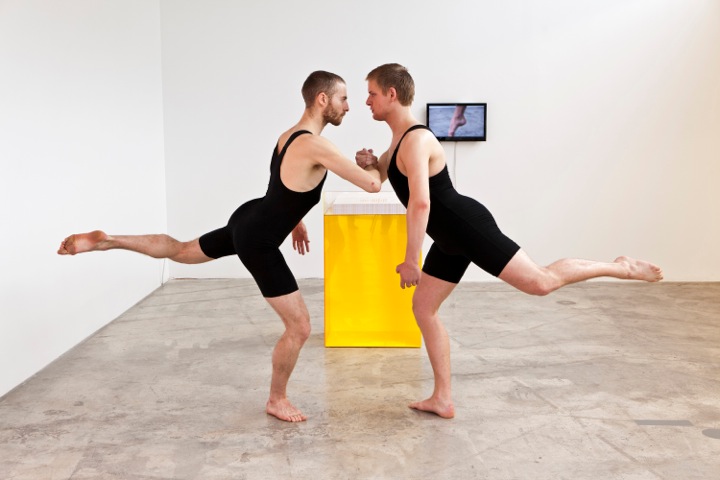
Encomium I, II, III, 2011
Live performance, videos, poster multiples, plexiglas plinths, vinyl
Courtesy of the artist
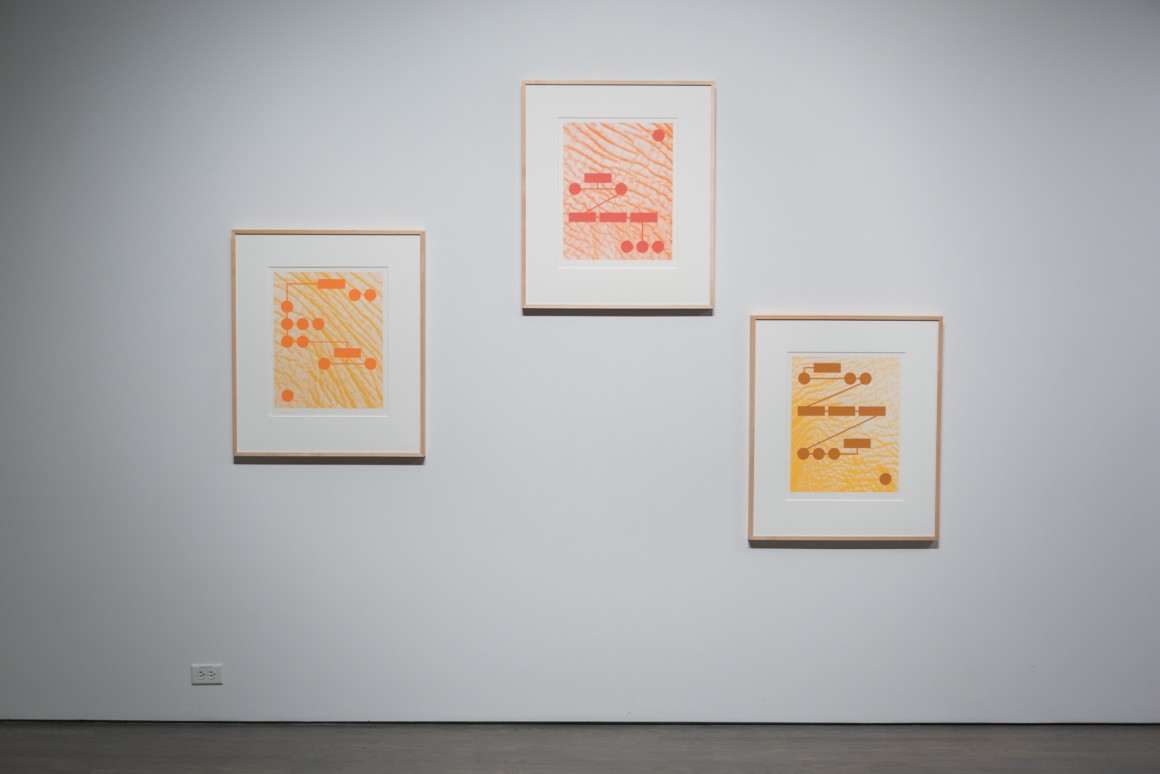
Symposium I, II, III, 2011
3 silkscreens on paper
Edition of 6
Courtesy of the artist
A choreographic interpretation of Plato’s classical text Symposium, Encomium brings into play endurance and physical prowess in a very concrete manner. Referring specifically to the speech of Phaedrus, which relates the asymmetrical love/sex relationship between a man and his younger lover, this work presents two male dancers in black leotard, performing a series of mirrored poses and movements prescribed by the artist. A set of elements displayed in the gallery space completes the installation, including three videos showing segments of the performance as well as three brightly coloured Plexiglas plinths piled with posters to take away. The posters contain Fernandes’ choreographic script for the performance, which constructs a dialogue between the Platonic text and the technical directions given to the dancers. In its exploration of the codification of language through the vocabulary of classical ballet, this work addresses reading not only as a metaphor for the genuine work of the body, but also as a “queered” physical exercise, articulating the role that reading plays in the construction of cultural and gendered identities. Like the video Performing Foe, presented at the entrance to the gallery, Encomium investigates the power dynamics at play in the pedagogical relationship and language learning through repetition, mimicry, and disguise.
LINKS
Artists’ website
Brendan Fernandes on Vimeo
Introduction to Maasai Necklaces in the framework of Disguise: Masks & Global African Art, Seattle Art Museum, 2015
Brian Fernandes in conversation with Jess Wilcox and Wendy Vogel in Bomb Magazine, 2014
Entrevue du Musée des beaux-arts du Canada sue Foe, 2012
Interview with the Brian Fernandes by Jade Yumang in Artfile Magazine, 2012
Jen Kennedy, “Undoing Identities: Brendan Fernandes’ Haraka Haraka, Montréal arts interculturelles” in FUSE Magazine, 2010
Brian Fernandes in conversation with Johan Lundh for Residency Unlimited, 2010
Gary Hill was born in 1951 in Santa Monica, California. He has worked with a broad range of media – including sculpture, sound, video, installation and performance – since the early 1970s. His longtime work with intermedia continues to explore an array of issues ranging from the physicality of language, synesthesia, and perceptual conundrums to ontological space and viewer interactivity. Exhibitions of his work have been presented at museums and institutions worldwide, including solo exhibitions at the Fondation Cartier pour l’art contemporain, the San Francisco Museum of Modern Art, Centre Georges Pompidou in Paris, Guggenheim Museum SoHo in New York City, Museum für Gegenwartskunst Basel, Museu d’Art Contemporani de Barcelona, and Kunstmuseum Wolfsburg, among others. Commissioned projects include works for the Science Museum in London and the Seattle Central Public Library in Seattle, and an installation and performance work for the Coliseum and Temple of Venus and Rome. Hill has received the Leone d’Oro Prize for Sculpture at the Venice Biennale in 1995, a John D. and Catherine T. MacArthur Foundation Fellowship Award in 1998, the Kurt-Schwitters-Preis in 2000, and honorary doctorates from The Academy of Fine Arts Poznan in 2005, and from Cornish College of the Arts, Seattle, in 2011. Recent projects include directing Beethoven’s opera Fidelio which premiered at the Lyon Opera House, and Feedback Path, a monumental multi projection installation in the Grotte du Mas D’Azil, France.
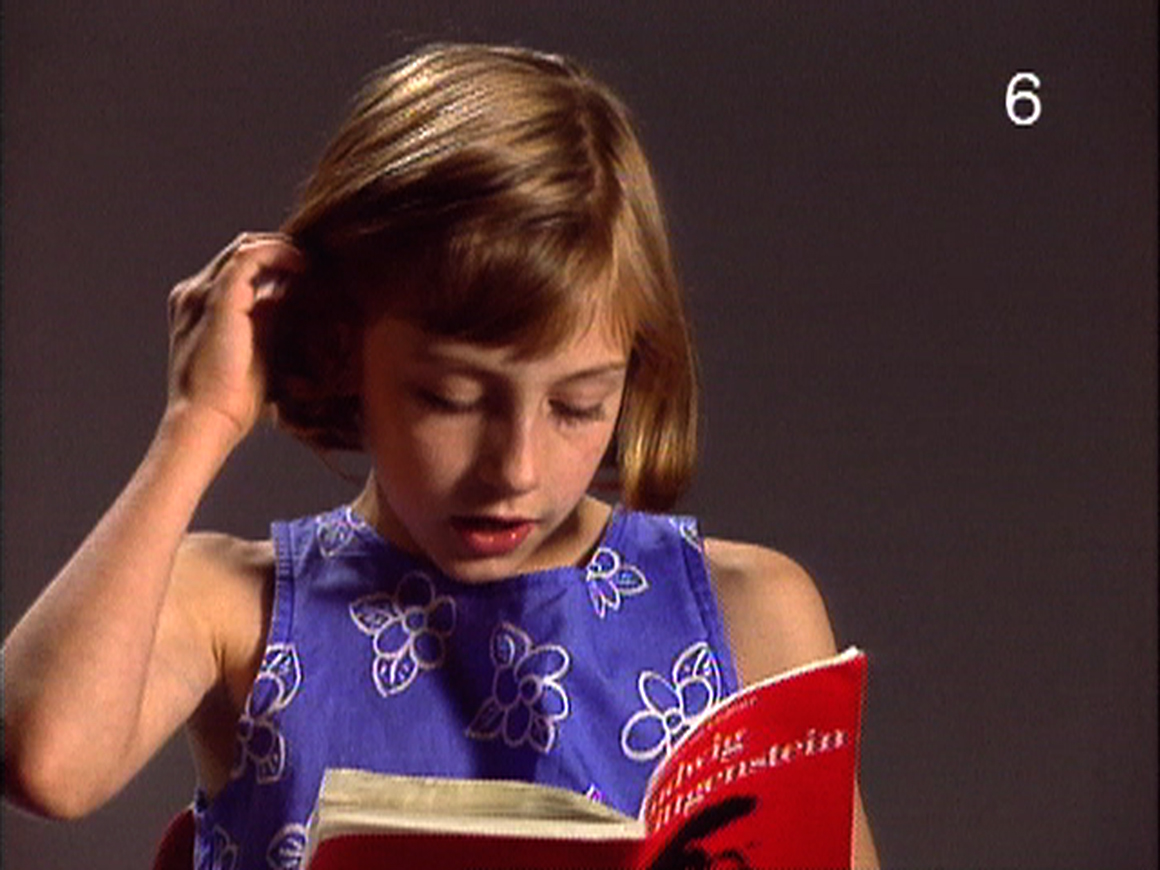
Remarks on Color / Remarques sur les couleurs, 1994-1998 (bilingual version, 2015)
Video projection, sound
45 min. and 49 min.
Courtesy of the artist and of the Musée d’art contemporain de Montréal
The bilingual version of Remarks on Color / Remarques sur les couleurs (1994-1998) that American artist Gary Hill has created especially for this exhibition alternates the original English video, which features his own daughter at the age of eight, and the French version produced by the Musée d’art contemporain de Montréal in 1998. This video installation, which also exists in German, Portuguese and Spanish, draws parallels between the efforts that learning to read requires on a strictly linguistic and phonetic level, and the often perplexing experience of reading philosophical texts. In an approximately 45-minute fixed camera view, a young girl reads out loud—without interruption but not without difficulty—the 88 segments comprising the first part of the book Remarks on Colour (German title: Bemerkungen über die Farben), written by Ludwig Wittgenstein in 1950-1951. In response to the visibly laborious exercise performed by the child, the spectator-listeners struggle to construct for themselves the precise meaning that is further complicated by the child’s mispronounced words (for example, “five-sided angels” instead of “five-sided angles”; “now” rather than “know”). The ambiguous process of “understanding” opens up and is almost made palpable by the slippery slopes of Wittgenstein’s remarks.
Readers :
Anastasia Hill (English)
Raphaëlle Occhietti (French)
LINKS
Artist’s website
Gary Hill on Vimeo
Gary Hill on UbuWeb
Lecture by Gary Hill at the Portland Art Museum, 2015
An Art of Limina: Gary Hill’s Works and Writings, Ediciones Poligrafa, 2009
Lise Jae Young on Gary Hill in Performing Arts Journal, 1996
Chris Darke on a Gary Hill seminar held on the occasion of his exhibition at the Oxford Museum of Modern Art in Frieze, 1994
Bouchra Khalili is based in Berlin. Born in Casablanca, she later studied Film at Sorbonne Nouvelle and Visual Art at the École Nationale Supérieure d’Arts de Paris-Cergy. Khalili’s work (film, video, installation, photography and prints) articulates language, subjectivity, and transitional territories to investigate strategies and discourses of resistance as elaborated and narrated by members of minorities. Khalili’s work has been internationally exhibited, as recently in 2015 at the 8th Goteborg Biennale, Europe: The Future of History at Zurich Kunsthaus, En y entre geografías at Medellin Museum of Modern Art, in 2014 at Here & Elsewhere at the New Museum in New York City, Positions at the Van Abbemuseum in Eindhoven, and at Journal, at ICA (Institute of Contemporary Art) in London, in 2013 in The Encyclopedic Palace at the 55th Venice Biennale, Cross-Border at the ZKM in Karlsruhe, and in Salon Der Angst at Kunsthalle Wien, and in 2012 at La Triennale at Palais de Tokyo in Paris and the 18th Biennale of Sydney, among others. Recent solo exhibitions include: Foreign Office at Palais de Tokyo in Paris and Garden Conversation at MACBA Barcelona, both in 2015, Speeches – Chapter 3: Living Labour at PAMM Miami, The Opposite of the Voice-Over at Justina M. Barnicke Gallery in Toronto, The Mapping Journey Project at CAC, La Passerelle in Brest, and Wet Feet and More at DAAD Galerie Berlin in 2013, a show at Galerie Polaris in Paris, and Wet Feet, Dry Feet at Tarragona Art Center in 2012. Khalili is also the recipient of the 2014 Abraaj Group Art Prize, and of the 2011-2013 Vera List Center for Art and Politics Fellowship, among others.
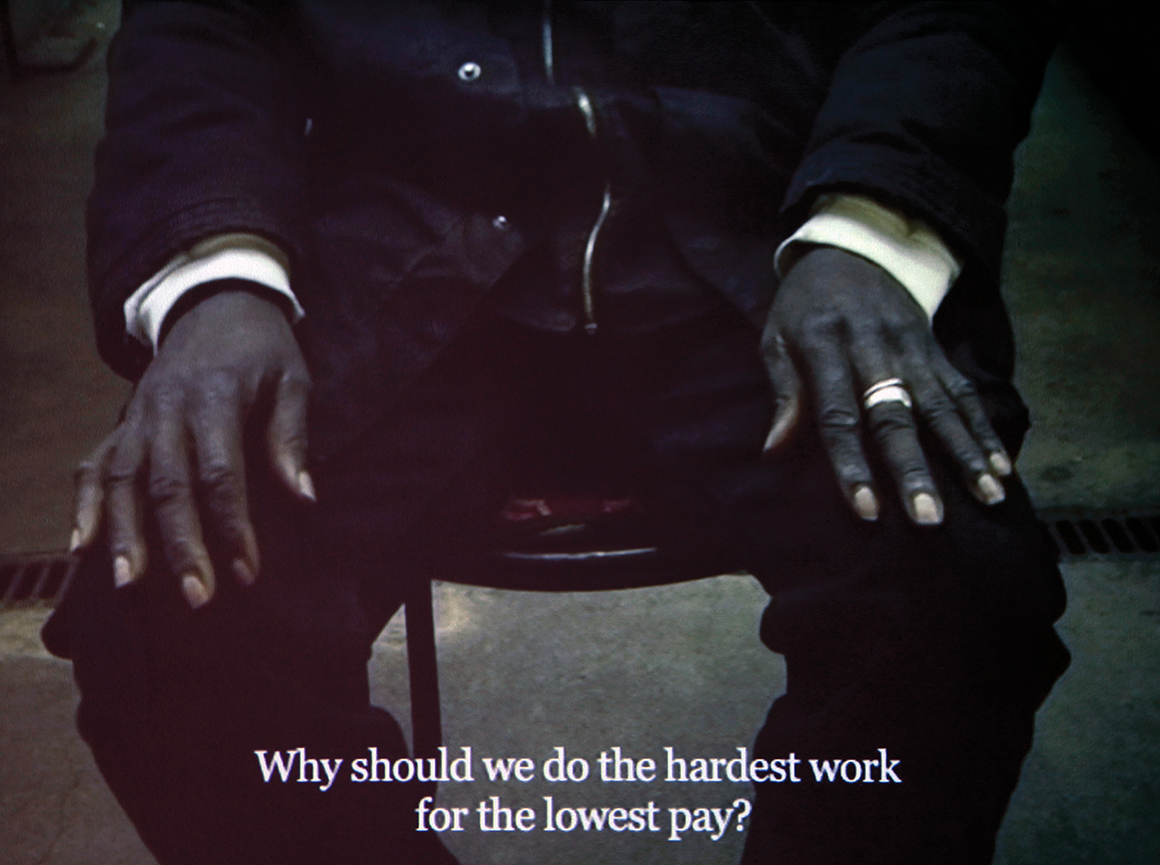
Speeches – Chapter 1: Mother Tongue, 2012
From The Speeches Series, a video trilogy, 2012-2013
Video projection, sound
23 min.
Courtesy of the artist / Galerie Polaris, Paris / ADAGP
Mother Tongue is the first chapter of The Speeches Series trilogy (2012-2013) by Franco-Moroccan artist Bouchra Khalili. This work confronts the political stakes of the re-appropriation of texts through a series of short video portraits in which five migrants of different origins, established in the Parisian region, recite, in their respective dialects, excerpts from political, literary, or poetic writings. Written by Malcolm X, Abdelkrim El Khattabi, Édouard Glissant and Patrick Chamoiseau, Aimé Césaire and Mahmoud Darwish, these texts address complex issues such as colonialism, the proletariat, immigration, and identity. For Mother Tongue, the participants translated the selected texts, memorized them, then performed them in front of a camera, thus acting as “civic poets” according to the definition proposed by Pier Paolo Pasolini in The Ashes of Gramsci (Le ceneri di Gramsci, 1957).
As Nick Aikens underlines, “[the] use of these texts in Mother Tongue, lifted from other contexts, histories and struggles and brought to bear in the here and now, helps to articulate the identity of those who speak; it performs what Stuart Hall saw as ‘find[ing] in the mirror of history a point of identification or recognition for yourself.’”1 The political perspective of the overall series redefines identity as identification to a civic status. While the second and third chapters (Words on Streets, 2013; Living Labour, 2013) shift from appropriation to authorship, inasmuch as the participants memorized and performed their own written texts, Mother Tongue can be seen as “discourse on method”, opening up to self-portraiture and self-representation. In Khalili’s work, the orality of language not only becomes a potential means of resistance and emancipation but also the basis for new political communities and a new relationship with history.
- Nick Aikens, “Bouchra Khalili’s ‘The Speeches Series’: A Reflection from Europe,” Afterall Online (January 5, 2015). Accesses May 28, 2015.
LINKS
Artist’s website
Nick Aikens on The Speeches Series on Afterall Online, 2015
“The Translation of a Translation,” a conversation between Bouchra Khalili and Thomas J. Lax, for the publication Foreign Office, published by SAM Art Projects, 2015
Diana Nawi on Bouchra Khalili’s cartographies in IBRAAZ Magazine, 2015
Nikki Lohr on Khalili’s exhibition at the New Museum in New York Observer, 2014
Bouchra Khalili in conversation with Omar Berrada on Universes in Universe, 2011
Lecture by the artist outlining the importance of cartography for her work at Rivington Place, London, in the framework of the exhibition Whose Map is it?, 2010
Bouchra Khalili lecture at Sharjah Art Foundation, 2010
Story Mapping bt Bouchra Khalili, published by Bureau des compétences, 2010
No Reading After the Internet is a salon series dealing with cultural texts, which are read aloud by participants. The particular urgency of the project is in reforming publics and experimenting with the act of reading, as its own media form, in our moment.
No Reading After the Internet poses itself as a space for experimental learning and discussion. Simply put, we are suspicious of our own reading abilities, and the extent to which our readings are conversant with one another. No Reading means to offer a space within which to retrace the steps used in constructing understanding, productively challenging individual and collective ways through the realms of language and interpretation. To participate in No Reading is to invoke an exuberant not-knowing, seeking out moments of collective illumination. The strategies we have at our disposal are twofold: through the yoking of our discussion to a text; and inducing conversation, where possible, between text and specific, local, contemporaneous exhibitions and happenings.
No Reading After the Internet is a project of the collective efforts of Amy Kazymerchyk, Alexander Muir and cheyanne turions.
cheyanne turions is an independent, Toronto-based curator and writer who holds a degree in Philosophy from the University of British Columbia. From the farmlands of Treaty 8, she is of settler and Indigenous ancestry. Her work approaches the space of exhibition as alive—the gallery is a space of dialogue where artists, curators and publics can reflect on and experiment with ways of seeing (and being). Most recently she curated Talking Back, Otherwise, a year-long exhibition at the Jackman Humanities Institute in Toronto. Forthcoming writing projects include contributions to MAWA’s Desiring Change: Contemporary Canadian Feminist Art and Duane Linklater’s The Wood Land School Reader. Her exhibition Other Electricities was presented the Award for Innovation in a Collections-based Exhibition by the Ontario Association of Art Galleries in 2014, and in 2015 she received the inaugural Reesa Greenberg Curatorial Studies Award and the Hnatyshyn Foundation’s Emerging Curator of Contemporary Canadian Art Award. She sits on the Board of Directors of Kunstverein Toronto, the Editorial Advisory Committee for C Magazine, and the Advisory Board for the newly federated institution comprising the Justina M. Barnicke Gallery and University of Toronto Art Centre.
Alex Muir is an art labourer and researcher based in Vancouver. He has been involved in the curation, digitization, and installation of numerous video-based projects at centres such as VIVO and the Western Front. He is also a programmer with the experimental radio collective Soundscapes on CFRO. He holds an MA in English from Simon Fraser University.
Amy Kazymerchyk is the curator of SFU Galleries’ Audain Gallery, at Simon Fraser University in Vancouver, BC. Her work with cheyanne turions and Alexander Muir began during her tenure as the Programmer of DIM Cinema at The Cinematheque (2008-2013). She collaborated with turions – then Programs Manager at Cineworks Independent Filmmakers Society – to present the reading group Thought on Film. When she became the Events and Exhibitions Coordinator at VIVO Media Arts Centre (2010-2013), Muir joined them in transfiguring the series into No Reading After the Internet. Kazymerchyk has curated numerous projects that investigate the intersections of collectivity, pedagogy and critical reading in cinema, media art and visual art including, Brad Butler and Karen Mirza’s The Museum of Non Participation (VIVO, 2010), Hito Steyerl’s Adorno’s Grey (with Melanie O’Brian, Audain Gallery, 2013), and Lili Reynaud Dewar’s My Epidemic (Teaching Bjarne Melgaard’s Class) (Audain Gallery, 2015).
#ReadTheTRCReport is a YouTube reading project which makes the entire Executive Summary of the Report of the Truth and Reconciliation Commission of Canada available online in video format.
After the TRC released the report, Zoe Todd, Erica Violet Lee and Joseph Murdoch-Flowers asked their networks to read 140 sections of the TRC report and upload them to YouTube. The resulting playlist is available on YouTube under the hashtag #ReadTheTRCReport. The Indigenous trio was inspired to start this project after reading the call that Métis activist, writer and teacher Chelsea Vowel issued on her blog âpihtawikosisân, for individuals to read the report in its entirety in order to engage with its findings.
The project aims to increase accessibility of the TRC Report, to bring the report to life, and to honour the survivors of residential schools. In her video contribution to the project, Todd said, “let’s keep this report from being shelved like so many before it”.
Erica Violet Lee is a Cree undergraduate student of philosophy at the University of Saskatchewan. She is an Indigenous feminist, and writes at moontimewarrior.com. Since speaking at the first Idle No More teach-in in 2012, Erica has been recognized as an international youth leader with the movement.
This summer, Erica was part of the #ReadTheTRCReport video project, which brought together settler, immigrant, and Indigenous voices across Canada to record a video and audio version of the 388-page Truth and Reconciliation Commission Report on Residential Schooling.
Zoe Todd (Métis) is from Amiskwaciwâskahikan (Edmonton) in the Treaty Six Area of Alberta, Canada. She writes about Indigeneity, art, architecture, decolonization and healing in urban contexts. She also studies human-animal relations, colonialism and environmental change in northern Canada. Her art practice incorporates writing, spoken word, beading, drawing and film to tell stories about being Métis in the Prairies. She is a lecturer in Anthropology at Carleton University, a PhD Candidate in Social Anthropology at the University of Aberdeen, and she was a 2011 Pierre Elliott Trudeau Foundation Scholar.
Joseph Paul Murdoch-Flowers is an Inuk whose roots are in Labrador and Nunavik. His father, maternal grandfather, paternal grandmother, aunts, uncles and cousins are residential school survivors. Joseph holds two law degrees and a bachelor in jurisprudence from McGill University. Prior to university, Joseph attended L’Institut de tourisme et d’hôtellerie du Québec, and then enjoyed a six-year career cooking in Montreal. Joseph now lives in Iqaluit, Nunavut with his wife and their child. He serves as the chair of the Apex District Education Authority and works as a criminal defence lawyer for the Legal Services Board of Nunavut.
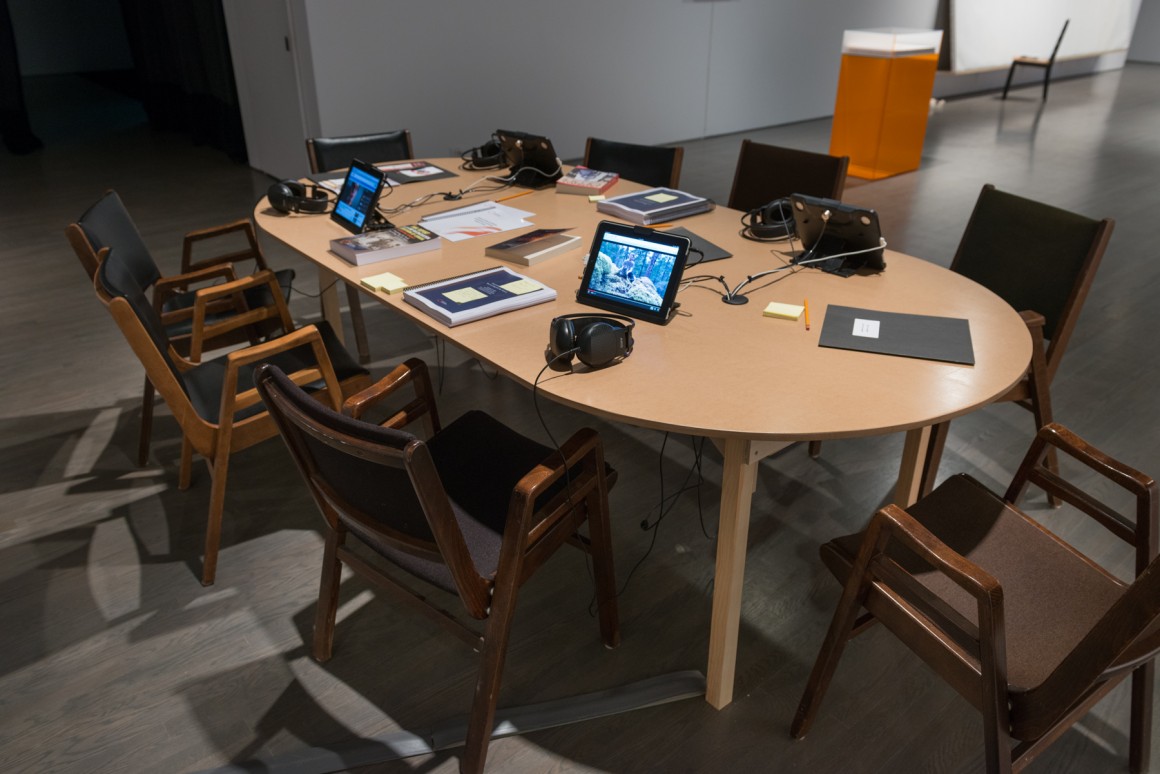
#ReadTheTRCReport, 2015
An initiative of Zoe Todd, Erica Violet Lee and Joseph Murdoch-Flowers, presented in collaboration with No Reading After the Internet, a project by cheyanne turions, Amy Kazymerchyk and Alexander Muir
A video project accompanied by a series of readings and conversations
Presentation with table, chairs, videos on digital tablets, books and documents
#ReadTheTRCReport is a citizen’s intiative generated by Zoe Todd, Erica Violet Lee and Joseph Murdoch-Flowers. This project was developed as a means of making the entire Executive Summary of the Report of the Truth and Reconciliation Commission of Canada available online in video format. The report acts as a testament to the “cultural genocide”1 perpetrated by Canada upon Aboriginal communities, notably by means of the residential school system. The document is meant to shed light on our complex collective history and “to lay the foundation for the important question of reconciliation”.2
In reaction to the publication of the report in June 2015, Métis teacher, writer, and activist, Chelsea Vowel, launched on her blog, âpihtawikosisân, a call inciting people to read the document in order to educate themselves on the permanent damages caused by our colonial history, and to critically engage with the TRC’s findings. The video reading project initiated by Todd, Lee and Murdoch-Flowers, serves as a direct response to Vowel’s call, as well as a means to increase the report’s accessibility, to bring it to life and to honour the residential school survivors. Using social media (twitter, facebook, e-mail, etc.), the trio has invited individuals from across Canada and elsewhere (Indigenous and non-Indigenous), to record themselves reading through one of 140 sections of the report, and to share their videos on YouTube. Accessible by searching #ReadTheTRCReport, the videos are integrated within a playlist containing the complete english version of the document.
A highly productive political exercise, this project is rooted within the current canadian understanding of the existing relations with indigenous communities. It testifies to the possibility – or rather the necessity – for each of us to exercise agency through the act of reading.
#ReadTheTRCReport’s presentation within the exhibition was proposed and co-organized by cheyenne turions, Amy Kazymerchyck and Alexander Muir, founders of No Reading After the Internet, a platform for experimentation and exchange based on the act of reading aloud. The dialogue between these two projects will be presented through a series of public readings and discussions that examine the process, structure and form of the report, histories of oral and textual testimony, and the role of literacy in political engagement. Within this context, visitors will equally be invited to contribute to the production of the yet to be undertaken French video edition of #ReadTheTRCReport.
- Truth and Reconciliation Commission of Canada, Honouring the Truth, Reconciling for the Future. Summary of the Final Report of the Truth and Reconciliation Commission of Canada, 2015, 1. Online (accessed October 29, 2015)
- Ibid., VI.
LINKS
No Reading After the Internet
#ReadTheTRCReport
cheyanne turions’ website
Truth and Reconciliation Commission of Canada Official Website
“Reaction to the TRC Report” by Chelsea Vowel
#ReadTheTRCReport on Zoe Todd’s Blog
Erica Violet Lee’s Moontime Warrior
Jane George on Joseph Paul Murdoch-Flowers on Nunatsiaq Online
#ReadTheTRCReport episode on IsumaTV
Lauren Strapagiel on #ReadTheTRCReport on Buzzfeed
Denise Balikssoon about #ReadTheTRCReport in the Globe and Mail
Nikki Wyart about #ReadTheTRCReport on CBC News
Ève K Tremblay, born in 1972, grew up between Val-David and Montreal. After studies in French Literature at the University of Montreal she attended The Neighborhood Playhouse School of The Theater in New York City. She completed a BFA with Photography Major at Concordia University in Montreal in 2000. During the past ten years, she has lived and worked between Montreal, Berlin and the New York metropolitan area and attended many artists residencies such as the iaab in Basel and the CEAAC in Strasbourg. In her works, the thematic of consciousness is explored with a poetic twist, inspired by literature, theater, cinema and science. Most pieces are photographs and videos including her friends, family members, and scientists. In 2007, she started a process-based cycle of works entitled EKTBF451/EKTFF451, broadening her practice to other mediums such as videos, performances, books, mixed medias, and image transfers on ceramics. Her works have been published and exhibited at the National Museum of Fine Arts of Québec, MAC/VAL in Vitry-sur-Seine, Bergen Kunsthall, Kunstraum Kreuzberg in Berlin, the Québec Triennial at the Musée d’art contemporain de Montréal, the Prague Biennale, and at Momentum 7, the Nordic Biennale in Oslo, at the Musée d’art contemporain des Laurentides, and soon at the Petach Tikva Museum of Art in Tel Aviv.

EKTBF451/EKTFF451 (Ève K. Tremblay Becoming Fahrenheit 451 / Ève K. Tremblay Forgetting Fahrenheit 451), 2007-2015
Book, photographs, drawings, collages, letters, ceramics and a video documentation of a performance
Courtesy of the artist
The project EKTBF451/EKTFF451 to which Ève K. Tremblay has devoted herself since 2007 consists of a personal test of the cognitive faculties solicited by reading, in particular, that of memory. Through this polymorphous performative work, the artist attempts in vain to “incarnate” Ray Bradbury’s novel Fahrenheit 451 (1953) by trying to memorize it: a feat that echoes that of the “book people,” the group of dissident readers depicted within the novel, who stand as guarantors for the memory of books condemned to be burned for the purpose of social control.
Through a series of repeated memory exercises inspired by the traditional mnemonic methods described by Frances A. Yates in her book The Art of Memory (1966), Tremblay’s project proposes an intense exploration of the creative possibilities and inevitable limits of the modern human mind. As reveals the selection of photographs, collages, drawings, ceramics, texts, and a video of a past performance, the process of forgetting in which the artist has been engaged for some time proves to be as difficult—or rather as impossible—as the previous step consisting of memorizing the entire book. Exhibited in this corpus is the worn, annotated copy of Fahrenheit 451, used by Tremblay since 2007, which bears witness to the compulsive or quasi-obsessive dimension that the act of reading can take on. This experience has involved for Tremblay a process of creation, self-reinvention, healing, and liberation, ultimately constituting a manner of being that goes beyond a simple manner of reading.
LINKS
Artists’ website
Ève K Tremblay’s Bookstore
Ludivine Maggi on the exhibition of Alain-Marie and Ève K. Tremblay at the MAC in Le Devoir, 2015
English translation by Zeljka Himbele, of the report on EKTBF 451/AKTF 451: Notes and Confessions at Miroslave Kraljevic Gallery, Zagreb by Leila Topic on HRT Radio, 2014
Canadian Art Feature by Daniel Baird, 2012
Nicoline van Harskamp’s recent works use and explore the English language that is created among non-native speakers worldwide, and imagine the (aesthetic) properties of a future spoken global language. After English Forecast, a 2013 commission by BMW Tate Live that outlined the first related issues, van Harskamp is now completing a series of “language experiments” with partners Extra City in Antwerp, Salonul de Projecte in Bucharest, the Radar Program in Loughborough, Onomatopee in Eindhoven, the Barcelona Art Residency, Kunstraum in London, and the Baltic Art Centre in Visby. Earlier works include Yours in Solidarity, a film and installation piece that addresses the recent history of anarchism through a correspondence archive, and Any other Business, a fully scripted conference day that was both staged live and reproduced as a video installation. Nicoline van Harskamp has presented her works at, among other places, the MUAC in Mexico City, the Frankfurter Kunstverein, Manifesta 9 in Genk, the National Museum in Oslo, D+T Gallery in Brussels, GMK Gallery in Zagreb, the Kadist Foundation in Paris, Performa 11 in New York, the SMBA Amsterdam, and the Biennials of Shanghai, Limmerick, Gothenburg, Bucharest, Taipei, and Sydney. She has staged her work live at KunstWerke in Berlin, the New Museum and rhizome.org in New York City, the Van Abbemuseum in Eindhoven, the Arnolfini in Bristol, the Serralves Foundation in Porto, the Stedelijk Museum Amsterdam, and the Kaaitheater in Brussels. She has been a resident artist at, among other places, the Rijksakademie in Amsterdam, Platform Garanti in Istanbul, and IASPIS in Stockholm. Nicoline van Harskamp was born in 1975 and lives and works in Amsterdam, where she teaches Fine Arts at the Sandberg Institute.
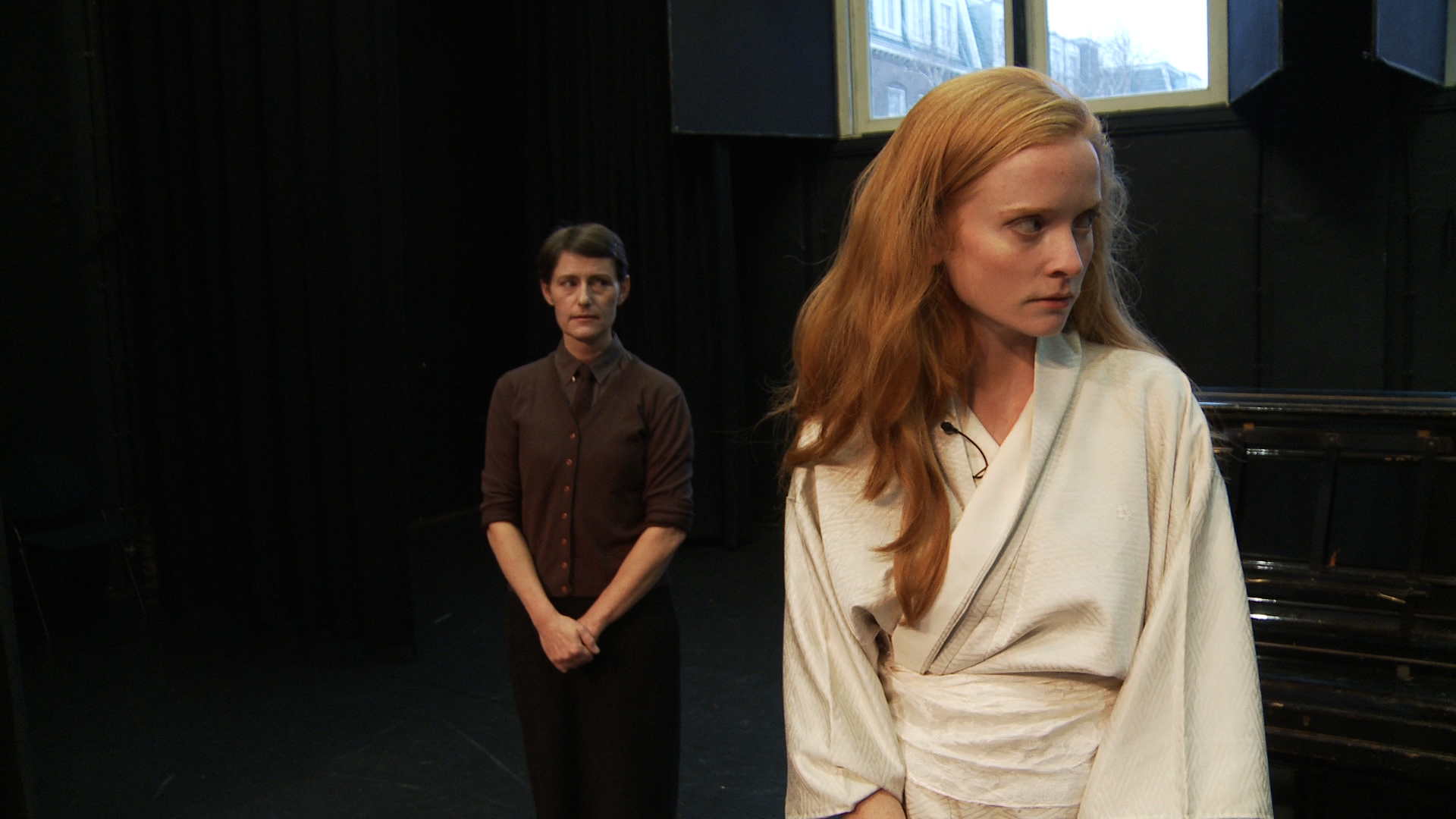
A Romance in Five Acts and Twenty-one Englishes, 2015
Courtesy of the artist
Made possible by the Mondriaan Fund
For several years, Nicoline van Harskamp, from the Netherlands, has been interested in the destandardization of English as a lingua franca of the globalized world. In 2014, she conducted a collective, intercultural language experiment based on 21 translations (in Turkish, Arabic, Japanese, Farsi, Czech, Croatian, Hebrew, etc.) of the play Pygmalion: A Romance in Five Acts written by George Bernard Shaw in 1912. During the four intensive three-hour sessions, van Harskamp asked the participants, whose mother tongues corresponded to the text they were reading, to simultaneously retranslate the text into English, resulting in a new version of the play, re-titled A Romance in Five Acts and Twenty-one Englishes.
The video installation featured in the exhibition is based on a recording of the play, performed on stage in Amsterdam in 2015, as well as the rehearsals held prior to the performance. For each of the five actors, English is a native language. Van Harskamp asked them to “normalize” the irregular and at times incomprehensible English created by the 21 retranslations with their “correct” pronunciation and intonation. The main video work presents the actors’ struggle to produce English sentences and words that seem utterly foreign to them. An extra audio track plays the original voices of the live translations, in synch with the actors’ voices.
While highlighting the particularities of the diverse “Englishes” spoken across the globe, this project underlines the power relations interconnecting language, social class and gender in Shaw’s theatrical narration, which inspired the famous musical comedy My Fair Lady (1956). In essence, Pygmalion tells the story of Eliza Doolittle, a poor young flower girl, as renowned phonetician, Professor Henry Higgins, takes her under his wing with the objective of teaching her to speak English like a lady, thus manipulating not only her pronunciation but also her identity.
Copies of the limited edition book A Romance in Five Acts and Twenty-one Englishes (2015), published by Onomatopee, are available for consultation at the reception desk.
LINKS
Artists’ website
Exhibition and limited edition of A Romance in Five Acts and Twenty-one Englishes, published by Onomatopee, 2015
Thisistomorrow on solo show at Kunstraum London, 2014
Tate Live Introducton, 2013
English Forecast at Tate Live: Performance Room, 2013
Frieze Case Study by Kathy Noble, 2012
Interview with Nicoline van Harskamp by Ceci Moss on Rhizome, 2011
Interview with Nicoline van Harskamp on her work To Live Outside the Law You Must be Honest by Emily Pethick, Casco, 2007
![]()
ADDITIONAL SOURCES OF INFORMATION
ADLER, Laure et BOLLMANN, Stefan (2006). Les femmes qui lisent sont dangereuses, Paris, Flammarion.
ADLER, Laure et BOLLMANN, Stefan (2011). Les femmes qui lisent sont de plus en plus dangereuses, Paris, Flammarion.
ARMSTRONG, Paul B. (2005). Play and the Politics of Reading : The Social Uses of Modernist Form, Ithaca, Cornell University.
ARMSTRONG, Paul B. (2013). How Literature Plays with the Brain: The Neuroscience of Reading and Art, Baltimore, The John Hopkins University Press.
AUBERT, Danielle (2015). Marking the Dispossessed, Zurich/Montréal, Passenger Books.
AUBOUY, Véronique et RIBOULET, Mathieu (2014). À la lecture, Paris, Grasset (livre d’artiste).
BACCINO, Thierry (2004). La lecture électronique, Grenoble, Presses Universitaires de Grenoble.
BACCINO, Thierry (2011). « Lire sur internet, est-ce toujours lire? », Bulletin des bibliothèques de France, vol. 56, no 5 (2011), Dossier « Métamorphoses de la lecture », p. 63-66.
BARON, Naomi S. (2015). Words Onscreen: The Fate of Reading in a Digital World, Oxford, Oxford University Press.
BARTHES, Roland (1973). Le plaisir du texte, Paris, Éditions du Seuil (Essais/Points).
BARTHES, Roland (1984). « Sur la lecture », Essais critiques IV. Le bruissement de la langue, Paris, Éditions du Seuil, p. 44-45.
BENNET, Andrew (dir.) (1995). Readers and Reading, Harlow, Essex, Longman.
BLOCH, R. Howard et HESSE, Carla (dirs.) (1995). Future Libraries, Berkeley et Los Angeles, University of California Press.
BON, François (2011). Après le livre, Paris, Éditions du Seuil.
BOYARIN, Jonathan (dir.) (1992). The Ethnography of Reading, Berkeley et Los Angeles, University of California Press.
BROOKS, Peter et JEWETT, Hilary (dir.) (2014). The Humanities and Public Life, New York Fordham University Press.
CARR, Nicholas (2010). The Shallows: What the Internet Is Doing to Our Brains, New York, Norton.
CARRIÈRE, Jean-Claude et ECO, Umberto (2009). N’espérez pas vous débarrasser des livres, Paris, Bernard Grasset.
CASTILLO DEBALL, Mariana (2002). Penser/Classer, Maastrich, Jan Van Eyck Academie (livre d’artiste).
CASTILLO DEBALL, Mariana (2005). Interlude: The reader’s traces, Maastrich, Jan Van Eyck Academie (livre d’artiste).
CAVALLO, Guglielmo et CHARTIER, Roger (2001 [1997]. Histoire de la lecture dans le monde occidental, Paris, Seuil (« Points »).
CERTEAU, Michel de (1990). L’invention du quotidien. I. Arts de faire [Quatrième partie : « Usages de la langue], Paris, Gallimard (folio/essais).
CHAN, Paul (2011). What is a Book? New York City, Badlands Unlimited.
CHARTIER, Roger (dir.) (1985). Pratiques de la lecture, Paris, Rivages.
CHARTIER, Roger (1992). L’Ordre des livres : lecteurs, auteurs, bibliothèques en Europe entre XIVe et XVIIIe siècle, Aix-en-Provence, Alinea.
CHARTIER, Roger (1989). « Le monde comme représentation », Annales. Économies, Sociétés, Civilisations, 44e année, no 6, 1989, p. 1505-1520.
CHEVALIER, Flore (2013). The body of Writing: An Erotics of Contemporary American Fiction, Colombus, Ohio State University Press.
CITTON, Yves (2014). Pour une écologie de l’attention, Paris, Seuil.
CRARY, Jonathan (2001). Suspensions of Perception: Attention, Spectacle, and Modern Culture, Cambridge, MIT Press.
CRARY, Jonathan (2013). 24/7: Late Capitalism and the Ends of Sleep, New York, Verso.
CULLER, Jonathan (1980). « Prolegomena to a Theory of Reading », in Susan R. Suleiman et Inge Crosman (dirs.), The Reader in the Text, Princeton, Princeton University Press, p. 46-66.
CULLER, Jonathan (2010). « The Closeness of Close Reading », ADE Bulletin, no 149 (2010), p. 20-25.
CUSSET, François (2013). « Ce que lire veut dire. La lecture, une affaire collective, une affaire politique », La Revue des livres, no 10 (mars-avril 2013), p. 11-16.
DAVIDSON, Cathy (1989) (dir.), Reading in America: Literature and Social History, Baltimore, John Hopkins University Press.
DAVIDSON, Cathy (2010). The Future of Thinking: Learning Institutions in a Digital Age, Cambridge, MIT Press.
DRUCKER, JOHANNA (dir.) (2012). Digital Humanities, Cambridge, MIT Press.
ECO, Umberto (1985 [1979]). Lector in Fabula ou La coopération interprétative dans les textes narratifs, trad. de l’italien par Myriem Bouzaher, Paris, Grasset.
FISH, Stanley (1980). Is There a Text in This Class? Cambridge, MA, Harvard University Press.
FLYNN, Elizabeth A. et SCHWEICKART, Patronicio P. (éd.) (1986). Gender and Reading: Essays on Readers, Texts, and Contexts, Baltimore et Londres, The John Hopkins University Press.
FLYNN, Elizabeth A. et SCHWEICKART, Patronicio P. (éd.) (1986). Reading Sites: Social Difference and Reading, New York, Modern Language Association.
FULLER, Danielle et SEDO, DelNel Rehberg (2013). Reading Beyond the Book: The Social Practices of Contemporary Literary Culture, New York, Routledge.
FUSS, Diana (1994). « Reading like a Feminist », in Naomi Schor et Elizabeth Weed (dirs.), The Essence of Difference, Bloomington, Indiana University Press, p. 98-115.
GALLOP, Jane (2000). « The Ethics of Reading : Close Encounters », Journal of Curriculum Theorizing, Fall 2000, p. 7-17.
GATES, Henry Louis Jr (dir.) (1990). Reading Black, Reading Feminist: A Critical Anthology, New York, Meridian.
GERITZEN, Mieke, LOVINK, Geert et KAMPMAN, Minke (dir.) (2011). I Read Where I Am: Exploring New Information Cultures, Breda, Graphic Design Museum; Amsterdam, Valiz.
GERVAIS, Bertrand (2006). À l’écoute de la lecture, Québec, Nota bene.
GUILLORY, John (2008). « How Scholars Read », ADE Bulletin, no 146 (2008), p. 8-17.
GUILLORY, John (2010). « Close Reading : Prologue and Epilogue », ADE Bulletin, no 149 (2010), p. 8-14.
HAYLES, N. Katherine (1999). How We Became Posthuman: Virtual Bodies in Cybernetics, Literature, and Informatics, Chicago, The University of Chicago Press.
HAYLES, N. Katherine (2007). « Hyper and Deep Attention: The Generational Divide in Cognitive Modes », Profession, 2007, p. 187-199.
HAYLES, N. Katherine (2010). « How We Read: Close, Hyper, Machine », ADE Bulletin, no 150 (2010), p. 62-79.
HAYLES, N. Katherine (2012). How We Think: Digital Media and Contemporary Technogenesis, Chicago, The University of Chicago Press.
HENTSCH, Thierry (2005). Raconter et mourir : aux sources de l’imaginaire occidental, Montréal, Les Presses de l’Université de Montréal.
ILLICH, Ivan (1991). Du lisible au visible : La naissance du texte. Un commentaire du Didascalicon de Hughes de Saint-Victor, trad. de l’anglais par Jacques Mignon, Paris, Cerf.
ISER, Wolfgang (1974). The Implied Reader, Baltimore, John Hopkins University Press.
ISER, Wolfgang (1978). The Act of Reading, Baltimore, John Hopkins University Press.
JAUSS, Hans Robert (1982). Toward an Aesthetic of Reception, trad. par Thimothy Bathi, Brighton, Harverster Press.
JONES, Nathan et SKINNER, Sam (2015). Torque #2: The Act of Reading, London, Torque, 2015.
JOUVE, Vincent (dir.) (2005). L’expérience de lecture, Paris, Éditions l’improviste.
LANG, Anouk (éd.) (2012). From Codex to Hypertext: Reading at the Turn of the Twenty-First Century, Amherst, University of Massachusetts Press.
LAROSE, Jean (2015). Google goulag : nouveaux essais de littérature appliquée, Montréal (collection papiers collés).
LEAVIS, Q.D. (1965 [1932]). Fiction and the Reading Public, Londres, Chatto & Windus.
LITTAU, Karin (2006). Theories of Reading: Books, Bodies and Bibliomania, Cambridge, Polity Press.
LONG, Elizabeth (1986). « Women, Reading, and Cultural Authority: Some Implications of the Audience Perspective in Cultural Studies », American Quaterly, no 38, p. 180-211.
MACÉ, Marielle (2011). Façons de lire, manières d’être, Paris, Gallimard.
MACHOR, James L. (dir.) (1993). Readers in History: Ninteenth-Century American Literature and the Contexts of Response, Baltimore, John Hopkins University Press.
MANGUEL, Alberto (1998). Une histoire de la lecture, trad. de l’anglais par Christine Le Bœuf, Paris, Actes Sud.
McGRATH, Brian M. (2013). The Poetics of Unremebered Acts: Reading, Lyrics, Pedagogy, Evanston, Ill., Northwestern University Press.
McHENRY, Elizabeth (2002). Forgotten Readers: Recovering the Lost History of African American Literary Societies, Durham et Londres, Duke University Press.
McLUHAN, Marshall (1962). The Gutenberg Galaxy: The Maxing of Typographic Man, Londres, Routledge & Kegan Paul.
MILLS, Sara (dir.) (1994). Gendering the Reader, Hemel Hempstead, Harvester Wheatsheaf.
NUNBERG, Geoffrey (ed.) (1996). The Future of the Book, Berkeley et Los Angeles, University of California Press.
ONG, Walter J. (1982). Orality and Literacy: The Technologizing of the World, New York, Routledge.
PAYOT, Marianne (2009). « Le livre ne mourra pas », entretien avec Umberto Eco et Bruno Racine (président de la BNF), L’express.fr, 15/10/2009 [en ligne] (consulté le 3 novembre 2014).
PEARCE, Lynne (1997). Feminism and the Politics of Reading, Londres, Arnold.
PEREC, Georges (1985). « Lire: esquisse socio-physiologique », La revue de l’AFL, Les Actes de lecture, no 10 (mars 1985), [en ligne] (consulté le 5 mai 2015)
PIPER, Andrew (2012). Book Was There. Reading in Electronic Times, Chicago et Londres, The University of Chicago Press.
RANCIÈRE Jacques (2011). Le Spectateur émancipé, Paris, La Fabrique.
SAENGER, Paul (1997). Space Between Words: The Origins of Silent Reading, Stanford, Harvard University Press.
SEDO, DeNel Rheberg (dir.) (2011). Reading Communities from Salons to Cyberspace, Basingstoke, Palgrave Macmillan.
SERRES, Michel (2011). « Éduquer au XXIe siècle », LeMonde.fr, 05.03.2011 [en ligne] (consulté le 2 novembre 2014)
SHANNON, Patrick (2011). Reading Wide Awake: Politics, Pedagogies, and Possibilities, New York, Teacher College Press.
STEWART, Garrett (2011). Bookwork: Medium to Object to Concept to Art, Chicago, The University of Chicago Press.
SOCKEN, Paul (éd.) (2013). The Edge of the Precipice: Why Read Literature in the Digital Age?, Montréal et Kingston, Londres, Ithaca, McGill-Queens University Press.
WEST, Mark (2014). Reading in the Mobile Era: A Study of Mobile Reading in Developing Countries, Paris, United Nations Educational, Scientific and Cultural Organization (UNESCO), Education Sector.
WOLF, Maryanne (2007). Proust and the Squid : The Story and Science of the Reading Brain, New York, Harper.
Rainer Ganahl’s Reading Seminars, NYC
If I Can’t Dance, I Don’t Want to be Part of Your Revolution, Amsterdam/Sao Paulo/Toronto
New York Times Feminist Reading Group, NYC
No Reading After the Internet, Toronto/Vancouver








